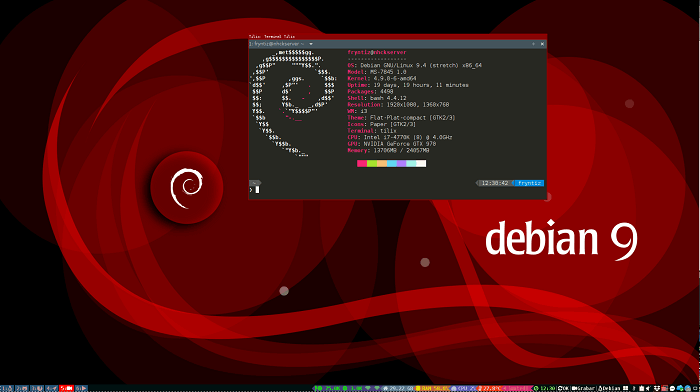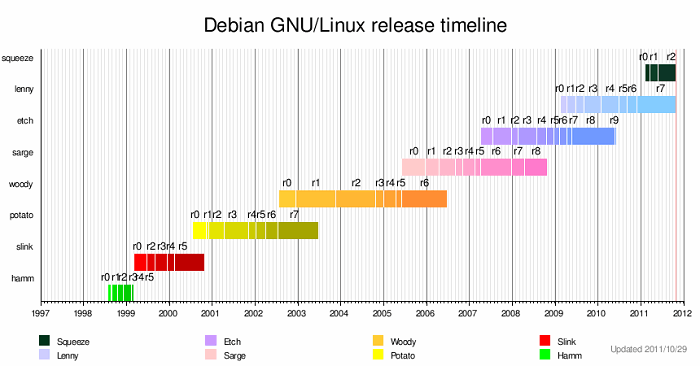History of Debian Operating Systems
Debian's initial release (version 0.01) was made available on September 15, 1993, and its initial stable release (version 1.1) was made available on June 17, 1996. The most widely used version of Debian for desktop PCs and servers is the Stable branch. Numerous other versions, most famously Ubuntu, are built on top of Debian. The next candidate is published following a time-based freeze, and new versions are continuously updated.
- Debian has always created and disseminated the GNU Project's guiding principles freely.
- The Debian Project is a group of people united in their desire to develop an open operating system.
- Debian is the name of the operating system that we have developed. Collecting fundamental applications and tools on your computer is an operating system.
- The computer's kernel, which performs all the necessary housekeeping and enables you to launch other programs, is its most essential application.
- The Linux kernel or the FreeBSD kernel is used in Debian servers.
- A piece of software called Linux was created by Linus Torvalds and is backed by thousands of coders all over the globe.
- An operating system called FreeBSD comes with a kernel and other programs.
- Debian for other systems, mainly for the Hurd, is being developed, though.
- The GNU effort created the Hurd as open software.
The terms GNU/Linux, GNU/FreeBSD, and GNU/Hurd refer to operating systems composed mainly of fundamental tools that are a product of the GNU effort. Also complimentary are these resources. Of course, people want application software, which includes tools for everything from document processing to business management to gaming and creating new software.
It has tower-like qualities. The nucleus is at the center. All of the fundamental instruments are on top of that. The program that you use to operate your computer comes next. Debian, meticulously arranging and fitting everything to function together, sits atop the structure.

History

Version History for Debian
Character names from the Toy Story movies are used as the basis for the code names of the Debian distributions. The unstable version of Debian is called after Sid, a toy-destroying character.
1. Founding (1993–1998)
Ian Murdock first introduced Debian on August 16, 1993, referring to it as "the Debian Linux Release" at the time. The Softlanding Linux System (SLS), the foundation for Slackware before Debian's introduction, was a well-liked Linux version. Murdock created a new version because he believed SLS needed more upkeep and a high bug count.
The first of several private versions was Debian 0.01, made available on September 15, 1993. The first public release, version 0.90, offered assistance via Pixar-hosted email groups. The Debian Linux Manifesto, describing Murdock's vision for the new operating system, was included in the distribution.
- The Free Software Foundation supported it for a year during this period.
- Bruce Perens was given responsibility for the Debian basic system by Ian Murdock, who concentrated on project administration. In 1995, the first ports to platforms other than IA-32 started, and Debian 1.1 was published in 1996.
- By then, the dpkg package system was already a crucial component of Debian, mainly due to Ian Jackson.
- Bruce Perens took over the project's management in 1996.
- Perens was a divisive figure who was considered autocratic and fiercely loyal to Debian.
- He created the Debian Social Contract and the Debian Free Software Guidelines by drafting a social contract and revising ideas from a month-long debate.
- Perens decided not to pursue re-engagement with the FSF after they withdrew their funding during the free software vs. open-source controversy and instead started the legal umbrella group Software in the Public Interest.
He oversaw the project's transition from a.out to ELF. He wrote a new launcher and the BusyBox software to enable running a Debian installer from a single floppy drive. Nearly 200 people were involved in the effort when Debian 1.2 was made available. In 1998, Perens quite the undertaking.
In 1998, Ian Jackson took the helm. The second formal version, m68k, was first available in Debian 2.0. Debian GNU/Hurd was the first non-Linux kernel to receive a translation during this period.
2. Election of a leader (1999–2005)
The project manager was chosen annually beginning in 1999. Along with Debian 2.1, the Advanced Packaging Tool was released. The project created the new member procedure because there were so many applications. In 1999, the first Debian variants, including Storm Linux from Stormix, Corel Linux, and Libranet, were launched. Joel Klecker, a coder who died from Duchenne muscular dystrophy, received a special tribute in the 2.2 version in 2000.
To lessen the block for the following release, the project restructured the repository with new package "pools" and established the Testing distribution, composed of safe packages. Developers started hosting DebConf, a yearly meeting with talks and seminars for programmers and technical users, that same year. Hewlett-Packard intended to use Debian as the foundation for its Linux work in May 2001.
- Due to the lengthy intervals between stable releases during these most recent release rounds, the Debian project received harsh condemnation from the free software community.
- While working on Sarge, a few things happened that caused disruption, including a hacker and arson assault on Debian computers.
- The Vancouver proposal stood out as one of the most notable. Release manager Steve Langasek revealed a plan to limit the number of supported versions to four to abbreviate upcoming release cycles following a conference conducted in Vancouver.
- Due to the proposal's appearance as a choice and the potential harm it would do to Debian's goal of becoming "the universal operating system," there was a significant response.
- On October 20, 2004, the "4.10 Warty Warthog" edition of the Debian-based Ubuntu operating system was available.
- According to Canonical Ltd., it gained popularity and success as one of the most widely used operating systems, with more than "40 million users" due to being made available for free distribution.
- Murdock, however, criticized the discrepancies between Debian and Ubuntu files, claiming that they cause problems.
3. Sarge and subsequent output (2005–present)
In June 2005, the 3.1 Sarge version was released. Over 9,000 new packages were added, and 73% of the software was upgraded in this version. Debian-Installer, a novel installer with a modular design, enhanced hardware recognition, enabled installations with RAID, XFS, and LVM support, made installations simpler for inexperienced users, and was translated into nearly forty languages. The amount of instructional, medically related, and accessible packages increased thanks to the work of Skolelinux, Debian-Med, and Debian-Accessibility.
Due to a highly documented legal battle, Mozilla software was renamed in Debian in 2006, with Thunderbird and Firefox forked as Iceweasel and Icedove, respectively. According to Mozilla Corporation, software with unapproved changes could not be disseminated under the Firefox trademark. The removal of non-free artwork and the provision of security updates are two reasons why Debian changed the Firefox software. A comparable agreement was expected for Icedove/Thunderbird.
In April 2007, Debian 4.0 (Etch), which included the x86-64 version and a graphical launcher, was published. In February 2009, Debian 5.0 (Lenny), which supported netbooks like the Asus Eee PC and Marvell's Orion architecture, was published. The developer Thiemo Seufer, who perished in an automobile accident, was honored with the publication.
The two-year cycle of time-based development restrictions was revealed in July 2009. The Squeeze period was supposed to be brief, but the original plan was scrapped.
- Debian 6.0 (Squeeze), which added a dependency-based start system and moved problematic hardware to the non-free part, was published in February 2011.
- Multiarch support was a feature of the May 2013 version of Debian 7.0 (Wheezy).
- Systemd was the replacement init system in the April 2015 version of Debian 8.0 (Jessie).
- The Debian 10.0 (Buster) version in July 2019 added Secure Boot functionality and enabled AppArmor by default.
- Debian 11.0 (Bullseye), which added support for driverless scanning, enabled persistency in the system log, and included kernel-level support for exFAT filesystems, was published in August 2021.
- Debian is still under development; every day, new files are added to unstable.
Since the introduction of Debian 9 (Stretch) in 2017, these massive sets of CDs for each architecture have been discontinued. Microsoft stated on December 2, 2015, that Debian GNU/Linux would be available as an approved distribution on the Azure cloud platform. Microsoft has also introduced the Windows Subsystem for Linux user environment, which provides a Debian subset, to their Windows 10 PC operating system.